
Nablus, a city in the modern-day Palestinian territory of the West Bank, is widely acknowledged as the birthplace of knafeh. The world’s biggest knafeh (74 meters long and 1.05 meters broad) was created in Nablus and holds the Guinness World Record. Some believe it was created in 15th-century Egypt, while others say it dates back to the Umayyad period in Damascus, Syria when it was consumed as a hearty suhoor meal before the fasting of Ramadan began.
Knafeh is a famous traditional Fatimid dessert that is often piled with cheese and sometimes additional ingredients like clotted cream, pistachios, or almonds. It is prepared from spun pastry called kataifi, which is soaked in a sweet, sugar-based syrup called attar. The Middle East is a major market for it. Turkey is home to its own variants as well.
The term might either mean “string pastry” or “dessert dish” in Arabic. In Turkish, tel kadayif refers to the string pastry, and künefe refers to the cheese-based dessert made with it. The shredded dough is the foundation of many Balkan and Greek foods, such as dessert pastries filled with nuts and sweet syrups, and goes by the names kadaif/cataif and kataifi, respectively.
Nabulsiye knafeh, a popular variation on the traditional Palestinian dessert, may be traced back to the city of Nablus. The cheese called Nabulsi, which is brined white, is used in Knafeh Nabulsiyeh. The crust is often orange or red, and crushed pistachio nuts are the standard topping. The meal is served in a huge circular shallow dish.
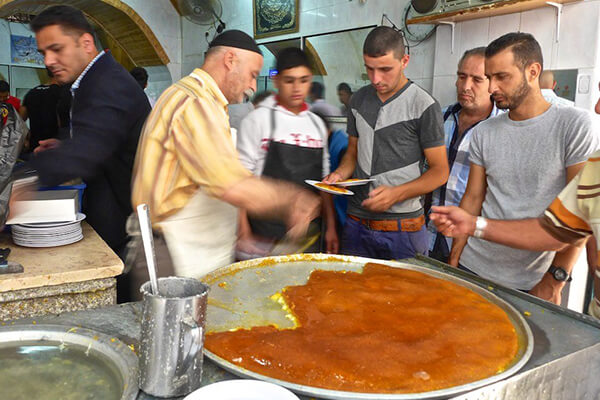
Which country is famous for Knafeh?
While knafeh is most commonly associated with the Arab world—and more specifically, the Levant, Egypt, and Palestine—it is also present in Turkey, Greece, and the Balkans, albeit in a somewhat different form.
The dessert’s history is as old as the conflict between Israel and Palestine; it’s constructed of vermicelli-like dough doused in sugar syrup, covered with soft cheese, sprinkled with rosewater or orange blossom, and topped with pistachios. Thirty miles from Jerusalem, Nablus makes a bright orange form of knafeh with a local white cheese called “jibneh Nabulsi.” Tensions have arisen because Israel claims Knafeh as its own without giving credit to Palestine for its development. Buzzfeed’s ad piece titled “17 Incredible Desserts From Around the World” caused a stir in 2014 when it included knafeh in its list of Israeli desserts.
Knafeh can be purchased in Azerbaijan and Turkey as well. The recipe varies from nation to country. The syrup used to sprinkle over the dessert in Syria is made with rosewater and orange blossom water from Lebanon. It’s common knowledge that Armenians include cinnamon and that Egyptians substitute clotted cream for cheese.
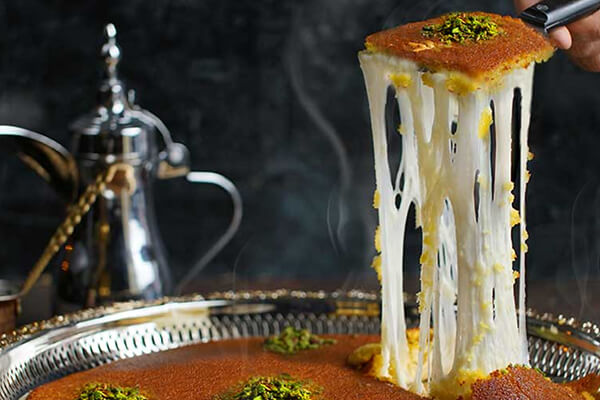
What is Knafeh?
Knafeh can be either soft or crunchy. ‘Khishneh’ is one option; it’s more rustic in appearance and features a topping of shredded phyllo dough (kataifi). The other is ‘na’ameh,’ which is topped with crushed semolina dough (farkeh) and has a smoother texture overall. Cheeses come in different types, depending on where you go.
The Arabic root word ‘kanaf’, meaning “to shelter” or “to protect,” is spelled a variety of ways in English, including knafeh, knafeh, kunafeh, kenafe, knefe, and kunafa. The two layers of bread sandwiching the cheese may have inspired this choice of term.
No matter what you call it—kunafa, kunafeh, or knafeh—this classic Palestinian dessert is a staple throughout Palestine and the rest of the Middle East. Nablus, the Palestinian business and cultural hub, is where it first gained widespread recognition for Knafeh.
The traditional kunafa is an explosion of deliciousness, with a sweet and crispy outside and a savory and gooey within. Arabs, Persians, Greeks, and Balkans have all long enjoyed this pastry, which is often fashioned from the thin skin hairs of pastry called kateifi. This dessert comes in a wide variety of forms.
Kunafa is a layered delicacy with a stringy white briny locally manufactured cheese at its center and a crusty shell that is syrup-dipped and pistachio topped.
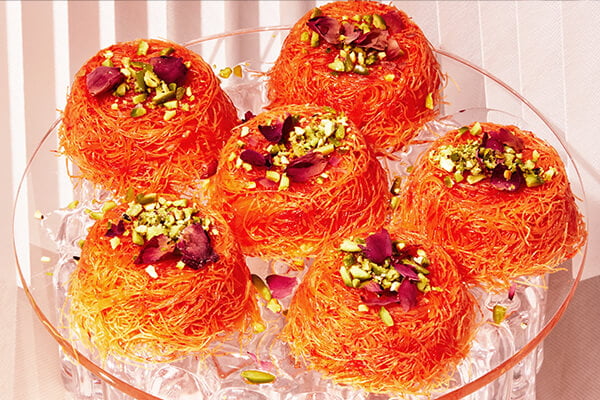
Different kinds of Knafeh
Since kunafa has been around for so long, individuals from all around the world have developed unique recipes for it. As a result, there is a great deal of variety. Different varieties of kunafa are available in many nations and regions. The particulars of this classic sweet vary from establishment to establishment that serves it.
A number of bakeries have developed their own unique recipes, while others have merely updated traditional ones. Here are three of the most common translations, broken down by nation of origin.
1. Kunafa of Turkey
In Turkey, they call it kunafeh. Tiny metal molds are used for baking each pastry separately. Unlike the Palestinian akkawi cheese, dil peyniri is a Turkish cheese that is utilized here.
Unsalted cow’s and sheep’s milk are used to make dil peyniri in Turkey. Kaymak, a sugary whipped cream, is a popular topping for kunefe in this nation.
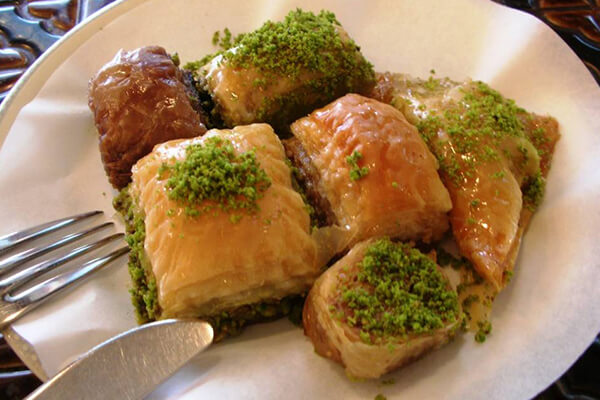
2. Kunafa in Lebanon
In Lebanon, this sweet treat is known as knefeh-bi-jibn. Mozzarella and wheat semolina are used, along with a syrup flavored with orange blossom water.
Kanafeh is a popular morning food in Lebanon, alongside traditional bread rolls made with sesame seeds called kaakeh.
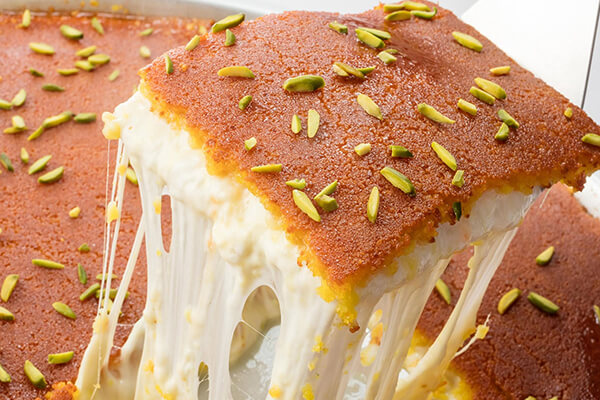
3. Kunafa in Jordan
In Jordan, they call these pastries kanafa. The dessert’s melty, velvety, and indulgent texture comes from a blend of mozzarella and ricotta.
The locals like to use a mixture of nuts, almonds, and raisins as a topping.
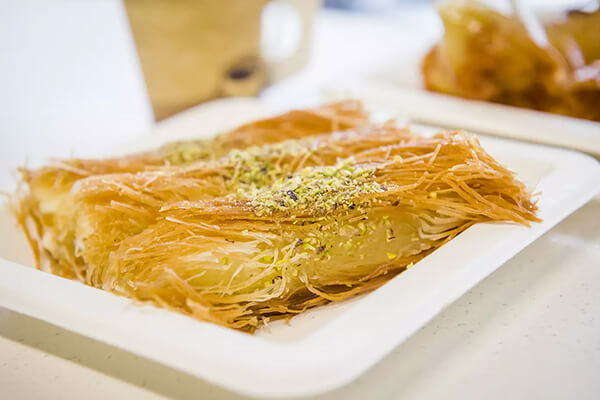
Conclusion
Kunafa is a popular dessert in many different Arab nations. During the holy month of Ramadan, this sugary delicacy enjoys a surge in demand.
The term “Kunafa” is spelled differently and prepared in different ways in many parts of the world. Cream or cheeses, ranging from mild regional cheeses to goat cheese, are typically used to fill or layer the dish.
Knafeh’s taste and ingredients might differ from one country to another. Most middle eastern countries have their own version of Knafeh, and it’s the beauty of it that you can pick a favorite based on your own interest and taste and go for it, right?



